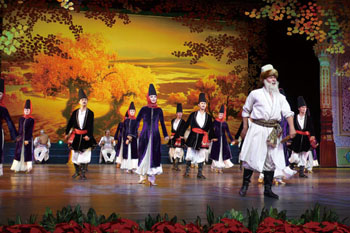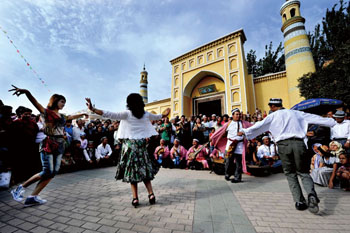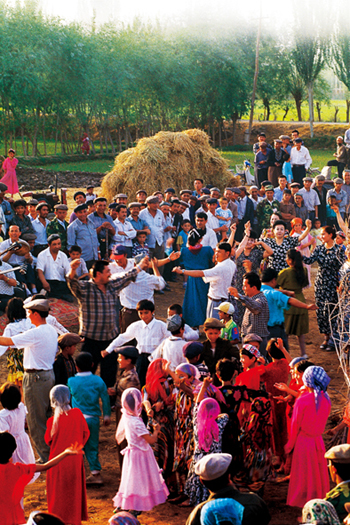Written by: Cheng Wanli
Posted on: January 16, 2013 |  | 中文
| 中文
 The Dolan people are a part of the Uygurs living along the Yarkant and Tarim Rivers. They mainly live in the Markit and Bachu Counties in the Kashgar area and in Awati County in the Aksu area. Meshrup is the most popular entertainment activity for the Uygur people. Everyone participates in these performances, men and women, young and old alike. There are several kinds of Meshrup, such as festival Meshrup, harvest Meshrup, hiking Meshrup, and ceremonial Meshrup. It is Dolan Meshrup which is celebrated with the highest enthusiasm.
The Dolan people are a part of the Uygurs living along the Yarkant and Tarim Rivers. They mainly live in the Markit and Bachu Counties in the Kashgar area and in Awati County in the Aksu area. Meshrup is the most popular entertainment activity for the Uygur people. Everyone participates in these performances, men and women, young and old alike. There are several kinds of Meshrup, such as festival Meshrup, harvest Meshrup, hiking Meshrup, and ceremonial Meshrup. It is Dolan Meshrup which is celebrated with the highest enthusiasm.
When the ancestors of the Dolan people came to live along the middle and lower reaches of the Yarkant River, they initially lived by fishing and hunting, before eventually turning to farming. At that time there were boundless primitive diverse-form leafed poplar woods, interminable reed grassland and large areas of marsh. The unique Dolan culture evolved during the period when they adapted to farming and gave up fishing and hunting, and was the product of the special environment the Dolan people lived in.
 Like the Meshrups of other Uygur groups, the Dolan Meshrup consists of four parts: music and dance, entertainment, performance and punishment. Unlike other Uygur dances, the Dolan dance is characterised by movements of the arms, knees and other parts of the body. Some scholars believe that the traditional Dolan dance is closely associated with the complete process of hunting of the ancestors of the Dolan people— hunters advancing in the woods, rapidly approaching the prey, fighting with it and finally killing it. This was followed by a celebration with singing and dancing. Later dancers no longer followed the dance steps and simply enjoyed it for entertainment. The Dolan dance stresses on the balance of whole body, especially the upper part. Dancers can change their positions constantly and move freely on the stage. As the beat becomes faster, the dancers become more excited. However, later on, when most of them have tired down and left the stage, the remaining one or two dancers become the stars of the dance, and are showered with the audience’s applause and praise.
Like the Meshrups of other Uygur groups, the Dolan Meshrup consists of four parts: music and dance, entertainment, performance and punishment. Unlike other Uygur dances, the Dolan dance is characterised by movements of the arms, knees and other parts of the body. Some scholars believe that the traditional Dolan dance is closely associated with the complete process of hunting of the ancestors of the Dolan people— hunters advancing in the woods, rapidly approaching the prey, fighting with it and finally killing it. This was followed by a celebration with singing and dancing. Later dancers no longer followed the dance steps and simply enjoyed it for entertainment. The Dolan dance stresses on the balance of whole body, especially the upper part. Dancers can change their positions constantly and move freely on the stage. As the beat becomes faster, the dancers become more excited. However, later on, when most of them have tired down and left the stage, the remaining one or two dancers become the stars of the dance, and are showered with the audience’s applause and praise.
 Games are played in the intervals. The most well-known traditional games are “Grasping Belt” and “Handing Bowl”. The former is held between young man and women in which a young man beats other young people with a cotton belt and the others try to escape while attempting to snatch away the belt at the same time. Both sides are quick in their actions, peppering them with jokes or funny words. ‘Handing Bowl’ is also an interesting game. A small bowl full of water is handed from one hand to another. It can be passed to anyone who participates in the game. Whoever spills the water will be punished, and he either has to sing a song, or has to tell a joke or tell the audience a witty saying.
Games are played in the intervals. The most well-known traditional games are “Grasping Belt” and “Handing Bowl”. The former is held between young man and women in which a young man beats other young people with a cotton belt and the others try to escape while attempting to snatch away the belt at the same time. Both sides are quick in their actions, peppering them with jokes or funny words. ‘Handing Bowl’ is also an interesting game. A small bowl full of water is handed from one hand to another. It can be passed to anyone who participates in the game. Whoever spills the water will be punished, and he either has to sing a song, or has to tell a joke or tell the audience a witty saying.
The third section of the Meshrup is the performance. Some read out their newly written poems, some tell jokes and some offer crosstalk. And there are two men who give comic shows that display their unique skills. Others will give performances voluntarily, either traditional or improvised. Punishment will be given to those who break the rules in the Meshrup, and they will be asked by the judge to perform some games.
The Dolan people love Meshrup so much that whenever they hear the sound of a drum, a hundred or even a thousand people would gather to join in the dance.
You may also like: